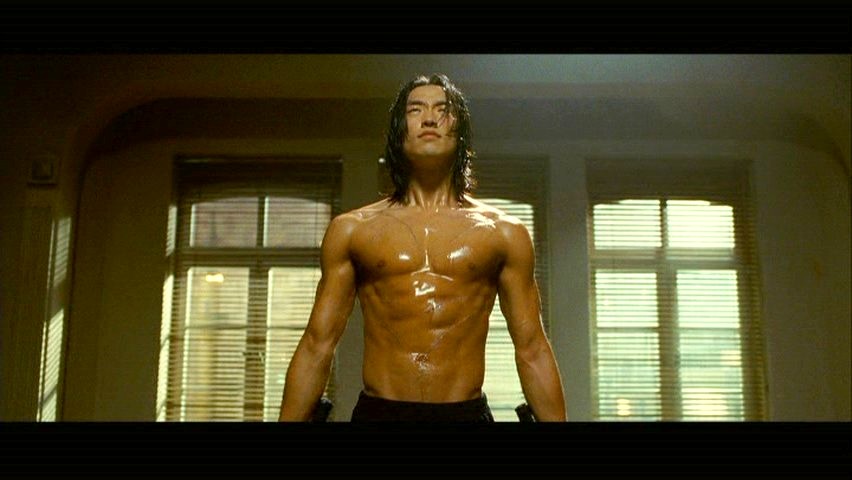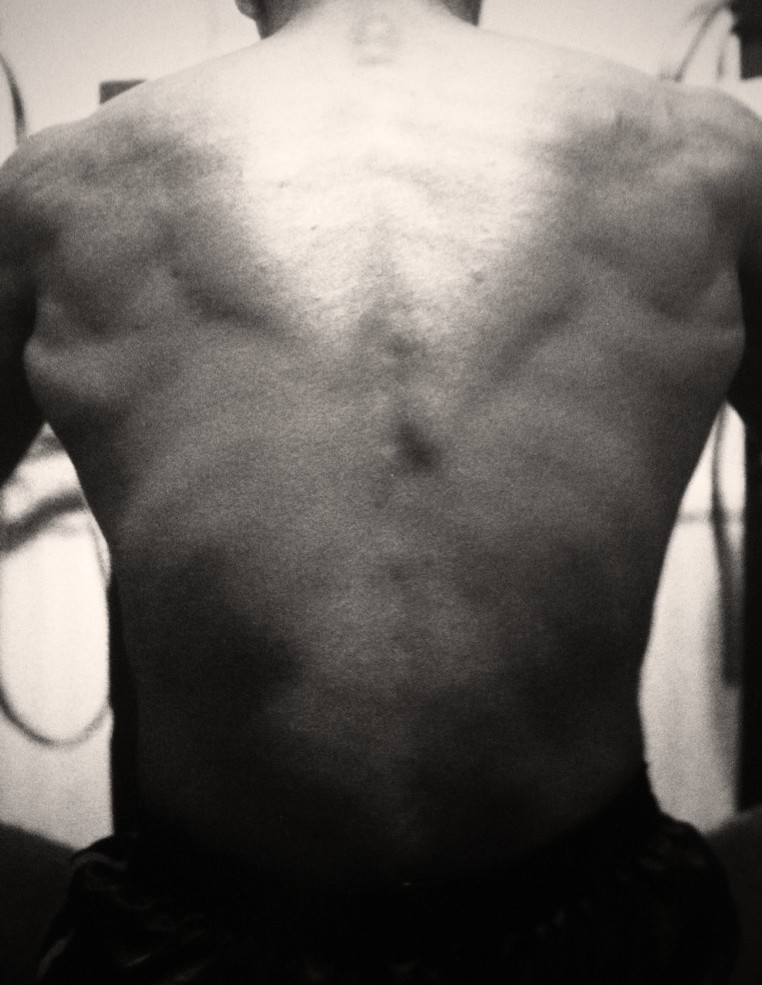
The warrior build is a lean, defined, proportionate look packed with strength and versatility.
Bruce Lee, Rain (ninja assassin) and Brad Pitt’s Tyler Durden character from Fight Club all reflect the warrior build to some degree.
The simplest, most effective means of building this physique is through progressively getting stronger whilst remaining lean and trim.
For many, that means stripping of body fat whilst preserving/building lean muscle tissue, through the combination of diet and heavy, progressive strength training. (It doesn’t get any simpler than that fellas).
Focus on boosting your strength and power to weight ratio. Every single pound on your body should have a reason to be there.
Breaking down the warrior physique

The Warrior physique is a lean, dense and proportionate build that prioritises strength and density over “puffy mass.” Every pound on your body has to earn its place, and pay rent in a manner of speaking.
The warrior build prioritises compact, solid, hard muscle, with incredible levels of leanness and definition.
The actual size of the muscles themselves may not be that impressive by bodybuilding standards, but they’ll be hard, cut and dense. The muscles will look like they’re literally carved from marble.
It’s the combination of a very low body fat and heavy strength training that produces this result.
An average amount of muscle mass, with exceptional definition brings about a much more impressive look, than a puffy, swollen, bloated looking physique.
Besides, training for dense muscle will have a lasting effect. Your muscle will look hard virtually all the time. Whereas, simply relying on higher rep, pump and fatigue training will only boost sarcoplasm (fluid) within the muscles, leading to a temporary swelling of the muscles.
This ultimately makes the muscles look bigger, but unfortunately it doesn’t last.
Anyway, moving on. Lets get to the meat and potatoes of this post.
The Essentials: The main movements of the “Warrior Routine”
- Weighted Chin-ups/pull-ups
- Weighted Dips
- Barbell Curls
- Incline Bench press
- Overhead Press
These are the exercises that will make up the bread and butter of your routine. Give them your undivided attention.
Pour your sweat and guts into them and you’ll carve out an impressively lean, dense and proportionate physique.
Increasing strength on these exercises alone will carry over and yield incredible results in terms of helping build and maintain an impressive physique.
Note: If you already have reasonably large thighs, you can drop or reduce emphasis on moves like squats and deadlifts.
Additional exercises/ contributing lifts
These are movements that complement the main lifts. They round out the routine and help fully develop the physique.
Chest: Incline Dumbbell Press
Deltoids (Shoulders): Lateral Raises and Face Pulls or Bent Over Flyes.
Back: Bent Over Rows
Legs: Squats, Deadlifts and Standing Calf Raises
Biceps: Seated Incline Hammer curls
Abs: Hanging Leg Raises and Planks.
Workout Overview
The overall volume and frequency is low. You’ll perform three workouts a week, each comprised of no more than 5 exercises per session.
Your primary objective is to improve strength on the on the main movements, which incidentally happen to be the one’s with (RPT) next to them.
Why low volume?
As mentioned earlier, higher volume, pump style training is not conductive to long term strength and dense muscle gains. (It’s worth repeating).
Put it this way, if you perform extensive volume and exercises per workout, you’ll end up stalling your strength gains and even regress.
It’s pretty well established that to make continual progress in the muscle gains department you need to get stronger over time.
Doing too many exercises will sap your strength during training and subsequently you’ll find your energy, focus and ability to lift heavy will waiver with the latter exercises. (Also increasing the likelihood of sustaining an injury as fatigue takes it’s toll).
Well that’s enough chatter. I’ve kept you waiting long enough. So hear it is folks….
The Warrior Routine
Note: Perform 2 warm up sets on first exercise of each muscle group. On RPT sets rest 2-3 minutes between sets to allow for optimal strength gains.
Workout A : Chest / Triceps / Deltoids
Incline Bench Press 3 x 5,8,10 (RPT)
Incline DB Press 2 x 6-8
Overhead Press 3 x 5,8,10 (RPT)
Lateral Raises 3 x 5-8
Dips 2 x 5-8
Notes on this workout: I like to emphasize heavy lateral raises. Most people perform them in the 8-12 rep range. I find that going slightly lower, working with 5/6 reps helps build density and caps the delts off nicely. Play around with it and see what works for you.
Workout B : Back / Biceps / Rear Deltoids
Weighted Chins/Pull-ups 3 x 5,8,10 (RPT)
Barbell Rows 3 x 5-8
Barbell Curls 3 x 5,8,10 (RPT)
Face Pulls w/rope attachment or Bent Over Flyes 3 x 8-12
Seated Incline Hammer Curls 3 x 8-12
Workout C: Legs / Abs (Optional)
Squats 3 x 5
Sumo Deadlifts 3 x 5
Standing Calf raises 3 x 4,6,12 (RPT)
Hanging leg raises 4 x 8-12
Plank hold 3 x 90 secs
Notes on this workout: You’ll notice I use RPT on calf raises. I’ve found that getting stronger in the 4-6 rep range with calves tends to yield better overall development. Calves are one of those areas that are stubborn as hell when it comes to growing. Be prepared to work them hard.
Means of progression
The aim of the game is to make some form of progress from workout to workout. Each training session you should be lifting heavier weight on the main lifts than your previous session.
I always aim to add anywhere from 2.5 – 5lbs to the bar each session. Constant progress, no matter how small is still progress and it adds up in the long run.
At the end of a 4-week period you could add 15- 20lbs to your lifts. (Damn fine progress). If you track your poundage, you’ll be able to see the progress you’re making and that’ll only help keep you motivated. (It’s a thing of Beauty).
What and why RPT?
If you’ve been lifting for a while, you probably have already come across RPT. This style of training has been increasing in popularity. Especially in strength circles.
RPT stands for Reverse Pyramid Training. It’s simply a way of training that involves beginning your session with your heaviest set first, while you’re fresh and full of energy.
Regular pyramid training involves building up to and ending with your heaviest set. With RPT you reverse the order.
The biggest benefit of training in this way is, that by starting with your heaviest set first (minus 1-2 warm up sets), you’ll find you’re stronger and lifting heavy won’t be as much of a struggle as it would if you were to lift heavy later on, as you become fatigued.
How long should I stick to this routine?
Thought you’d never ask.
I usually find it best to stick with a program for at least 8-12 weeks. Forget all that “muscle confusion” bullshit. Your body needs a chance to actually get used to the movements and improve at them before you switch up and do something else.
If you constantly program hop in search of “the next best thing”, you’ll never get the full benefits from the routine.
My thinking when it comes to training is to “milk” all the benefits and results that a program has to offer me. When progress comes to a halt, I’ll switch things up.
The problem is people change programs and exercises way too soon.
What about Cardio?
As leanness is a prerequisite for the warrior physique, most people will find they need cardio to help them reach and maintain a low body fat percentage. For cardio I usually go for walks with my dog on a daily basis, which covers low intensity cardio
On rest days or days when I’m not hitting the iron I’ll hit some sprints for a little high intensity cardio and to keep my anaerobic system in good condition. (Never know when you’ll have to out run an army of zombies).
You can play sports, hike, swim etc. Do whatever the hell you like, as long as it’s something you enjoy and doesn’t interfere with your strength training.
You don’t need to go cardio crazy. Just 15-20 mins of high intensity work 1-2 times a week on rest days will suffice. For low intensity cardio 30-45mins is fine.
To sum up:
- Hit the iron 3 days a week
- Focus on progressive overload on main moves
- Do some cardio and abs on rest days
- Be patient and enjoy the process.
In part two we’ll delve into eating for the warrior physique. Don’t miss out. Subscribe now.
If you liked the article and found it informative and want a fully structured program and nutrition guide that breaks everything down and goes into more detail when it comes to building the warrior physique, head over and grab a copy of WARRIOR 101.